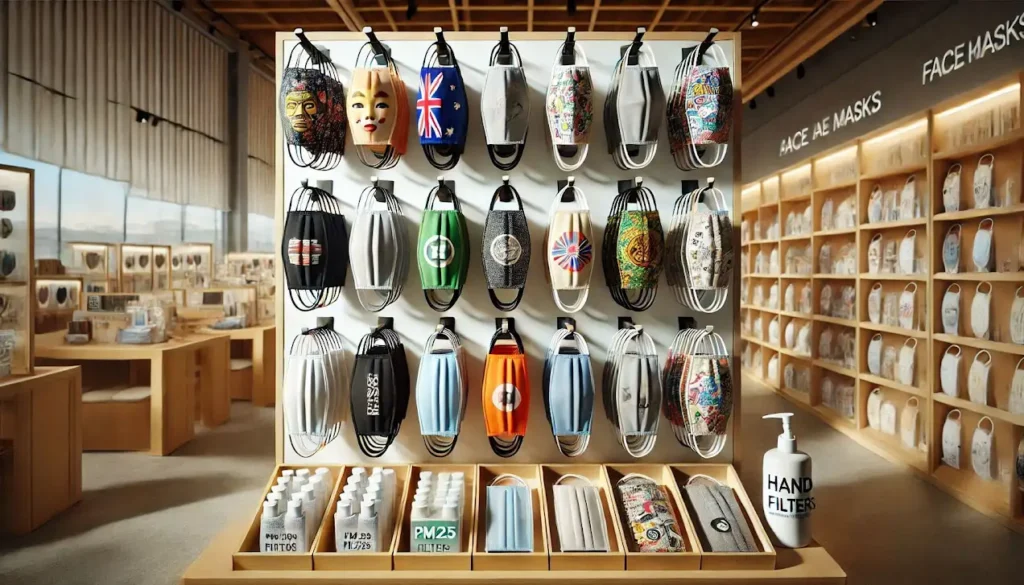From Hidden Threats to Visible Protection: Understanding Indoor Air Quality in Real Estate
The landscape of real estate viewings has undergone a dramatic transformation, with indoor air quality emerging as a critical consideration for both professionals and clients. Modern buildings, despite their pristine appearances, often harbor invisible threats in the form of microscopic particles, making PM2.5 protective masks an indispensable tool during property inspections. These ultrafine particles, measuring 2.5 micrometers or less, can originate from various sources within properties, including deteriorating building materials, ventilation system residue, and accumulated environmental pollutants.
Professional real estate agents are increasingly recognizing the significance of respiratory protection during property viewings, particularly in older buildings or properties that have remained vacant for extended periods. The accumulation of dust, mold spores, and other airborne contaminants creates an environment where PM2.5 masks become crucial for maintaining respiratory health. Recent studies conducted by building safety organizations have demonstrated that indoor air quality can be up to five times worse than outdoor air, especially in poorly ventilated spaces.
The integration of PM2.5 protective masks into real estate viewing protocols represents a proactive approach to occupational safety. These specialized masks offer a sophisticated filtration system capable of capturing particles that would otherwise penetrate standard face coverings. The implementation of such protective measures not only safeguards health but also demonstrates a commitment to professional responsibility and client welfare during property inspections.
The evolution of real estate safety practices has led to the development of comprehensive guidelines that emphasize the importance of proper respiratory protection. Industry leaders have documented numerous cases where exposure to poor indoor air quality during property viewings has resulted in respiratory issues, highlighting the necessity for adequate protective measures. This growing awareness has catalyzed a shift toward more rigorous safety protocols in real estate operations.
Microscopic Defenders: The Science Behind PM2.5 Filtration Technology
The engineering principles underlying PM2.5 protective masks represent a remarkable achievement in filtration technology. These masks utilize multiple layers of specialized materials, each serving a distinct purpose in the filtration process. The outermost layer typically consists of a water-resistant material that repels larger particles and moisture droplets, while subsequent layers employ increasingly fine mesh structures to capture progressively smaller particulates.
Advanced filtration mechanisms in PM2.5 masks incorporate electrostatically charged fibers that actively attract and trap microscopic particles. This sophisticated approach ensures the capture of both solid particulates and liquid aerosols that may be present during property viewings. The filtration efficiency of these masks is particularly crucial when inspecting properties with known air quality concerns or historical preservation sites where ancient building materials may release harmful particles.
The technological advancement in filter media has led to the development of materials that maintain high filtration efficiency while allowing sufficient airflow for comfortable breathing. Modern PM2.5 masks achieve this balance through precise engineering of pore sizes and distribution patterns across the filter surface. This optimization ensures that real estate professionals can maintain clear communication and physical comfort during extended property viewings without compromising protection.
Research and development in filtration technology continue to enhance the performance of PM2.5 masks. Innovations in material science have introduced new filter compositions that offer improved particle capture rates while reducing breathing resistance. These advancements directly benefit real estate professionals who require consistent protection during multiple property inspections throughout their workday.
Beyond Basic Protection: Professional Standards and Compliance Measures
Establishing comprehensive safety protocols for real estate viewings requires careful consideration of regulatory requirements and industry best practices. Professional organizations have developed specific guidelines for the selection and use of PM2.5 protective masks during property inspections. These standards encompass various aspects, including filtration efficiency ratings, fit testing procedures, and proper maintenance protocols to ensure optimal protection.
Compliance with safety regulations extends beyond the mere provision of protective equipment. Real estate agencies must implement training programs that educate agents about proper mask usage, maintenance, and replacement schedules. Documentation of these safety measures has become increasingly important, particularly in regions with stringent occupational health requirements. Organizations must maintain detailed records of mask specifications, fit testing results, and regular equipment inspections.
The integration of PM2.5 protective measures into standard operating procedures requires systematic implementation and regular review. Property viewing protocols now include pre-inspection safety assessments that evaluate air quality risks and determine appropriate levels of respiratory protection. This proactive approach helps agencies maintain compliance while demonstrating their commitment to professional safety standards.
Industry certifications and accreditations increasingly recognize the importance of proper respiratory protection during real estate activities. Professional development programs now incorporate modules on indoor air quality assessment and protective equipment usage. This emphasis on safety compliance has elevated the standard of practice within the real estate sector while providing tangible benefits for both agents and clients.
Risk Assessment and Strategic Implementation in Property Viewings
Developing effective strategies for implementing PM2.5 protective measures requires comprehensive risk assessment protocols. Real estate professionals must evaluate multiple factors when determining appropriate respiratory protection levels for different property types. These assessments consider building age, renovation history, ventilation systems, and potential sources of airborne contaminants that may impact indoor air quality during viewings.
Strategic implementation of protective measures involves careful planning of viewing schedules and duration. Properties with identified air quality concerns may require limited exposure times or additional ventilation procedures before and during inspections. Real estate agencies have developed sophisticated scheduling systems that incorporate these safety considerations while maintaining efficient viewing operations.
The collection and analysis of air quality data during property viewings provide valuable insights for refining protective strategies. Advanced monitoring devices can detect PM2.5 levels in real-time, allowing agents to adjust their approach based on actual conditions. This data-driven methodology enables organizations to optimize their safety protocols while maintaining productive viewing schedules.
Documentation of risk assessment findings and implemented safety measures serves multiple purposes in real estate operations. These records provide evidence of due diligence in protecting agent and client health, support continuous improvement of safety protocols, and contribute to the industry’s growing body of knowledge regarding indoor air quality management during property viewings.
Client Communication and Safety Education Initiatives
Effective communication regarding PM2.5 protective measures plays a crucial role in successful property viewings. Real estate professionals must articulate the importance of respiratory protection without creating unnecessary anxiety among clients. Educational materials and pre-viewing briefings have become standard practice, ensuring that all parties understand the purpose and benefits of using protective masks during inspections.
Professional agencies have developed comprehensive client education programs that address common questions and concerns about PM2.5 protection during viewings. These initiatives often include detailed explanations of indoor air quality risks, the effectiveness of protective measures, and the agency’s commitment to maintaining safe viewing environments. Clear communication helps establish trust while demonstrating professional expertise in property safety matters.
The integration of safety education into marketing materials has emerged as an effective strategy for promoting responsible viewing practices. Agencies highlight their commitment to client and agent protection through various communication channels, including property listings, website content, and social media platforms. This transparent approach to safety communication has become a distinguishing factor in competitive real estate markets.
Building lasting client relationships requires consistent demonstration of professional responsibility and care. Regular updates on safety protocols, including improvements in protective equipment and viewing procedures, help maintain client confidence. Many agencies now include safety briefing materials in their standard viewing packages, ensuring that clients are well-informed about protective measures before attending property inspections.
Innovation and Adaptation in Professional Safety Equipment
The evolution of PM2.5 protective masks continues to enhance real estate viewing experiences through innovative design features. Manufacturers have responded to industry needs by developing masks that combine superior filtration with improved comfort and communication capabilities. These advancements include enhanced breathability, better voice projection, and designs that minimize eyewear fogging during property inspections.
Research collaboration between equipment manufacturers and real estate organizations has led to specialized mask designs for professional use. These purpose-built solutions address specific challenges faced during property viewings, such as extended wear periods and the need for clear verbal communication. The resulting products represent a significant improvement over generic protective equipment, offering features tailored to real estate activities.
Technological integration in protective equipment has introduced smart features that enhance safety monitoring during viewings. Some advanced PM2.5 masks now incorporate sensors that track breathing patterns and filter efficiency, providing real-time data through mobile applications. This technology enables professionals to monitor their protection levels and maintain optimal safety conditions throughout their workday.
The customization of protective equipment for different viewing scenarios has become an important consideration in real estate operations. Organizations maintain various mask options suitable for different property types and environmental conditions. This adaptable approach ensures that agents can select appropriate protection levels while maintaining professional appearance and functionality during client interactions.
Measuring Success: Performance Metrics and Continuous Improvement
The effectiveness of PM2.5 protective measures in real estate viewings can be evaluated through various performance indicators. Organizations track key metrics including air quality measurements, incident reports, and feedback from agents and clients. This data provides valuable insights for refining safety protocols and improving protective equipment selection.
The only list in this article details essential performance metrics for evaluating PM2.5 protection programs: * Air quality monitoring results during property viewings * Agent compliance rates with protective equipment protocols * Client satisfaction scores regarding safety measures * Incident reports related to respiratory concerns * Equipment maintenance and replacement records * Training completion rates for safety protocols * Cost-effectiveness of protective measures
Systematic analysis of performance data enables organizations to identify areas for improvement in their safety programs. Regular review meetings bring together key stakeholders to discuss findings and implement necessary adjustments. This continuous improvement process ensures that protective measures remain effective while adapting to changing industry conditions.
The long-term success of PM2.5 protection programs depends on maintaining consistent evaluation and improvement cycles. Organizations must regularly update their protocols based on new research, technological advancements, and practical experience. This commitment to continuous improvement demonstrates professional excellence while ensuring optimal protection for all participants in real estate viewings.



